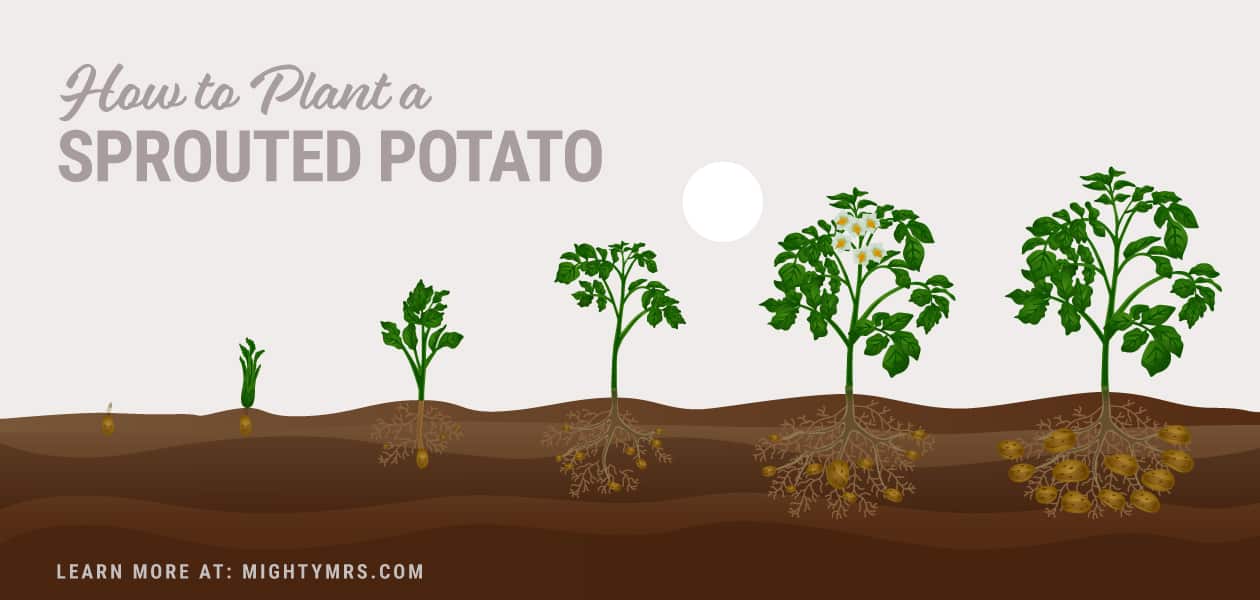
This post may contain affiliate links. As an affiliate, I earn a commission.
Did you discover the potatoes you bought from the grocery store awhile back and forgot about have suddenly sprouted in the depths of your pantry? What should you do? Toss them out? No way! They're still good! You can actually plant those sprouted potatoes to regrow new potatoes and I'm going to tell you how to do it
Can you plant sprouted potatoes?
Yes! You can plant a sprouted potato and grow more potatoes.
You will actually get several potato plants and ultimately a bunch of new potatoes from just one sprouted potato if you do it right.
How to Regrow Sprouted Potatoes
You can plant any kind of sprouted potato from sweet potatoes to yellow or white potatoes.
Here's how.
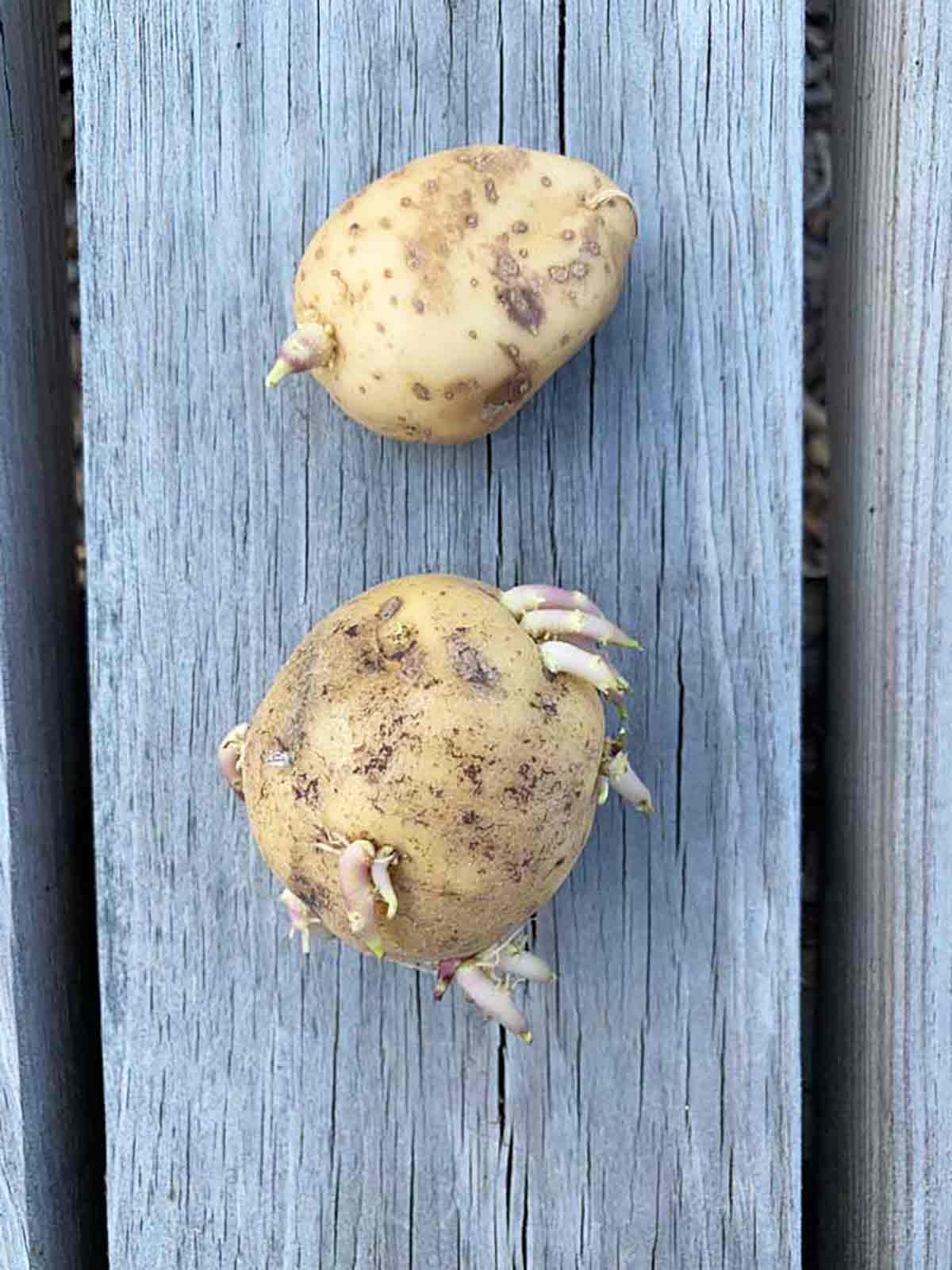
First, don't plant the whole potato in the ground. You'll need to do a little bit of prep to get your sprouted potatoes ready for planting for best results. Don't worry, it's easy. You don't need to be a gardening expert to pull off growing potato plants. Just follow these steps...
Step 1
First, prep your garden bed by mounding soil into rows.
You'll want to plant your potato sprouts within 2-3 days of preparing them so it's best to get your garden bed ready to go, first.
Potato plants grow best when you mound the dirt. This is because potatoes grow underneath the soil. The leaves of the potato plant grow above ground but the roots and potatoes will all develop underground. So the bigger the mound of dirt you create, the more room the potatoes will have to grow.
You can easily mound the soil in your garden by scooping the dirt on either side of the row you create and piling the dirt up in the middle. You want the soil to mound between 8" and 12" tall.
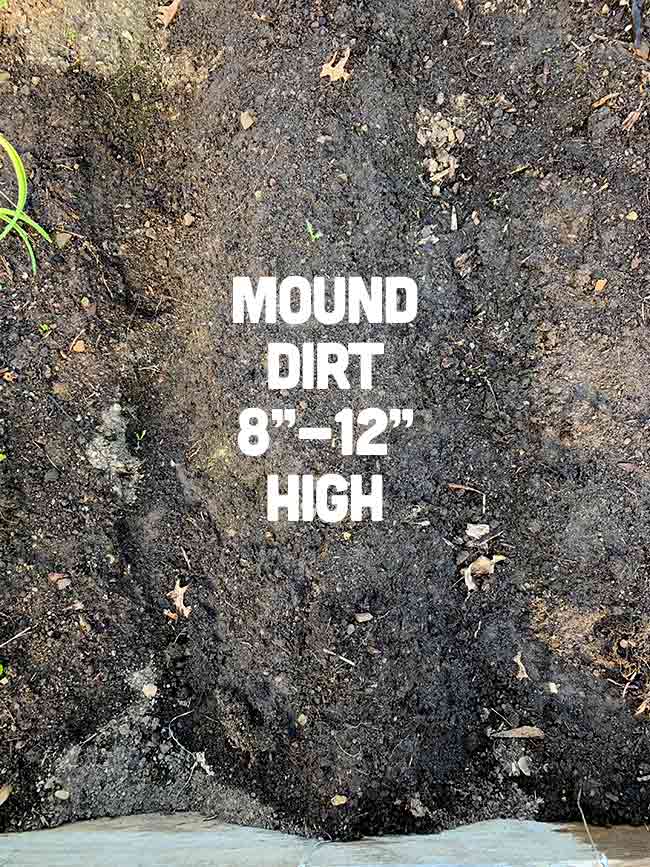
I don't use a special tool for this other than gloves. I just mound the soil with my hands. For larger gardens, you can use a shovel, gardening hoe or rake.
Rows should be about 1 foot apart.
FAQ: When should I plant my potato sprouts?
When you plant, depends on where you live. Generally, early spring is when you will want to plant. You will need to make sure the ground temperature does not drop below 40°F (5°C). Generally the ground is warm enough 2-4 weeks before the last frost of the spring.
Note: Potato plants grow best in soil with a temperature of 45-50°F (8-10˚C). However, can grow in warmer conditions as well.
You can start your potato plants indoors for before transplanting to the ground if the soil temperature is still too cold.
Step 2
Count your potato sprouts.
The number of plants you'll be able to get from each potato will depend on how many sprouts the potato has.
A potato sprouts from the eyes on the potato. Each sprouted eye can be cut and grown into a plant. If an eye has multiple sprouts, go ahead and leave those grouped together when you make your cuts.
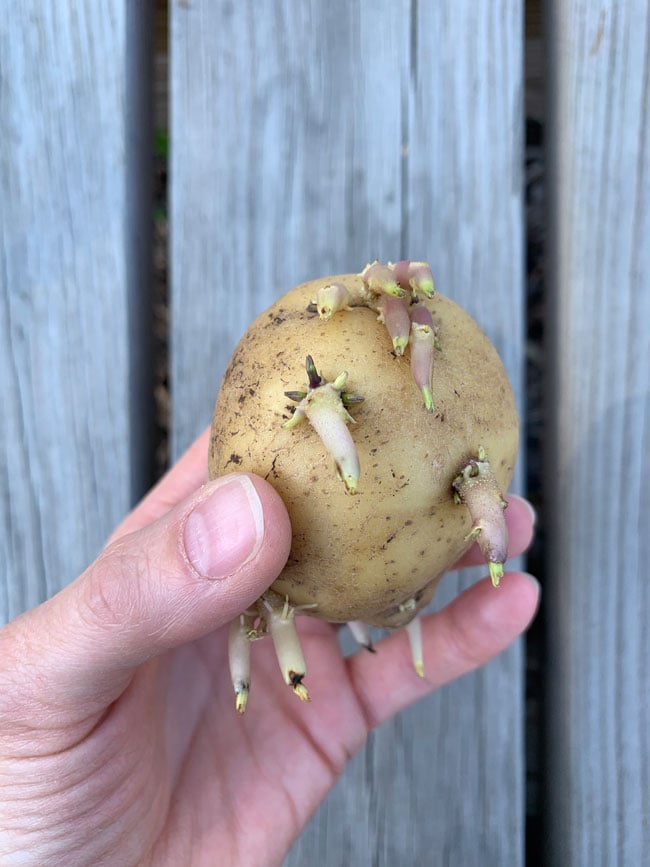
Each sprouted potato will offer a different number of sprouts.
Step 3
Cut each sprout using a serrated kitchen knife.
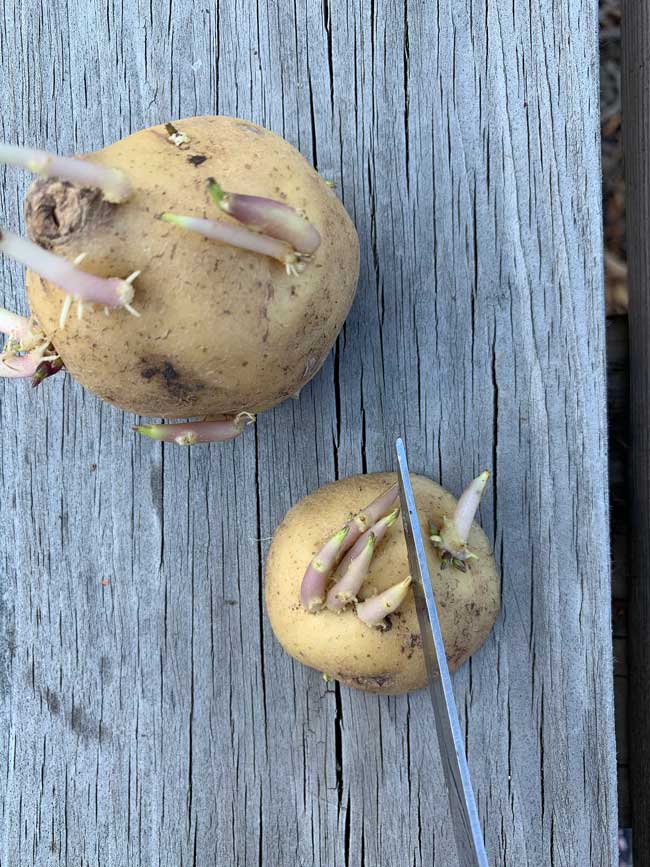
Separate the sprouts by cutting away each sprout or group of sprouts, leaving a small amount of potato attached to the sprout.
You'll want to plant your potato sprouts within 2-3 days of cutting. Ideally, you will want the skin to dry enough to seal out disease but not too much so that the sprouted parts dry up. You do not need to store the sprouts in water or soak them before planting. Do store them in a cool, dry place after cutting.
Step 4
Plant your potato sprouts.
Potato sprouts should be planted cut-side down, sprout-side facing up. You'll want to plant each sprout 3-4" below the surface of the soil. Plants should be spaced out at least 12" apart so the plants have room to grow both below and above ground.
Planted potato sprouts will take about a weeks to push through the soil and open up their leaves. Keep the plants watered and make sure they get plenty of sun.
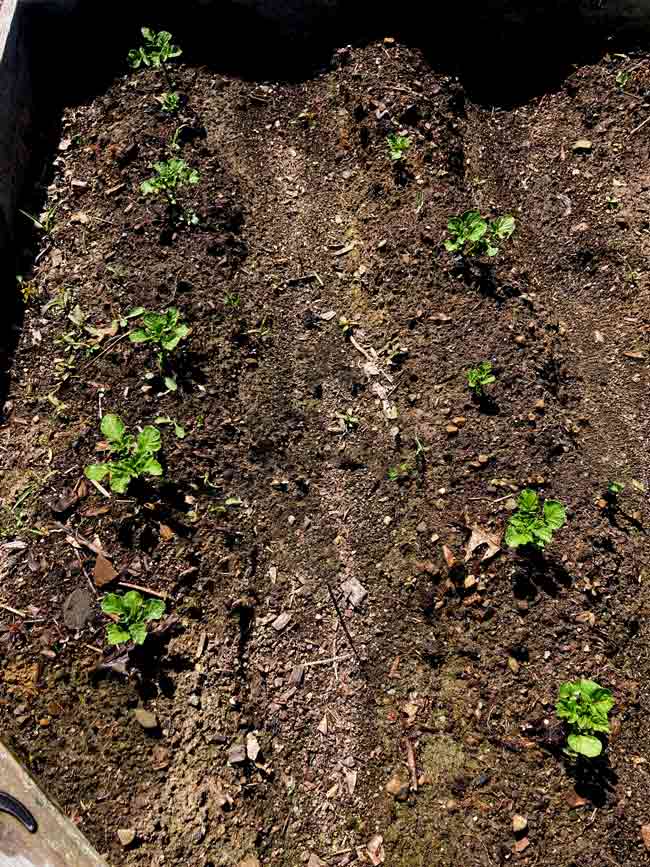
Step 5
Continue to water and weed around your potato plants.
Fertilize your soil if its not very rich. As the plants grow, you can continue to mound soil around the base of the plant.
In general, potatoes need about 3 months to grow and produce a harvest. Some varieties may require more or less time.
Step 6
Harvest your potatoes.
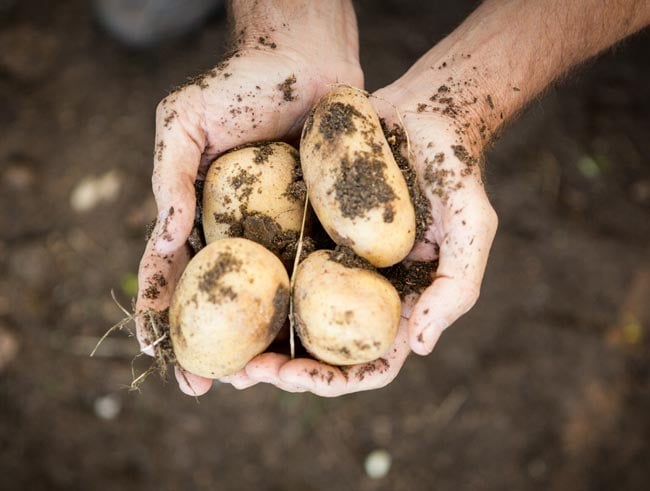
Since the potatoes grow underground, its tricky to tell what you'll get in terms of size or number of potatoes. However, you'll known that your potato plants are ready to be harvested when the visible plant dies off either after the first frost or on its own, usually in the fall.
Then for the fun part! Harvesting potatoes is like digging for treasure. Grab a garden fork and/or some garden gloves if you want to use your hands and dig in! Sift throw the mounded dirt until you find your potatoes. You'll likely get a variety of sizes.
Do not wash your harvested potatoes. You want to keep potatoes dry to avoid rot. To clean off the dirt, use a dry, soft vegetable brush. Store them in a cool dry place. Potatoes can usually be stored for up to 6 weeks or more.
If your potatoes begin to sprout before you get to use them... well, now you know what to do! Use that sprouted potato to grow more potatoes!
Potato Hardiness
The best potato growing season is spring through summer with a fall harvest but that can vary depending on where you live.
Potatoes grow best in cooler climates with at least 6 hours of sunlight a day. Potatoes will not typically survive temperatures less than 40˚F. Too warm isn't good either though. Soil temperatures warmer than 80˚F may fail to produce to potatoes.
Storing Seed Potatoes
If you're not in a location where temperatures are warm enough to plant your sprouted potatoes, you can store them.
To store them, you want to put them in a location that is between 35-40˚F. A cool, dark and dry place is key. Your refrigerator or a cold basement would work. These conditions will force them to go dormant until you're ready to plant.
When you are ready to re-activate them, move them to a warm location. It's OK if they have become dry and wrinkled as long as they are not mushy and rotten (if they smell bad they are rotting). Some light and a little moisture can help them sprout again.
You do not want to freeze them or leave them outside if temps drop below 35 or go above 50˚ at any point in time. The ideal temperature range should remain between 35-40˚ Refrigerators are typically 40˚.
Did you know you can also plant sprouted onions?
Learn how to plant onions that have sprouted!
Now let's make some food!
While you're here, check out my easy recipes to get ideas for what to make with your garden-fresh potatoes!

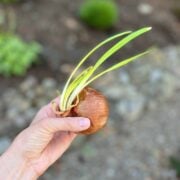



Sharla says
Thanks for this very interesting article. I am new to potato growing but it sounds great to me to get more potato plants from fewer seed potatoes.
I have a question: Is this method of planting potato sprouts any quicker or slower than planting chitted whole seed potatoes? Thanks.
Angela G. says
Hi Sharla, I would say this process is very similar to planting chitted potatoes. Chitted potatoes are simply ones that are woken up from their dormant state and have begun sprouting. This is what has already happened when a potato starts sprouting in your pantry. I have planted both store bought potato seeds and cutting of sprouted potatoes and I haven't noticed much of a difference as far as speed in plant growth. The plants get pretty big quickly but then you do have to wait the whole season for the potatoes to grow to a decent size, underground. Hope this helps!
Bettina Wright says
What a great article. Thank you so much! I have a potato that sprouted so I put it in water to see what would happen and now I have a plant sitting in the water with all these white roots sitting in the water. I am not sure if it's too late to plant it, but I'll give it a shot and see what happens. My pup and I love sweet potatoes! 🙂
Brian Cassid says
Question re: Both potatoes and onions. My family used to have an in-ground root cellar below our house and everything stored/over-wintered very well. But, I find that my modern basement just isn't cool enough to store for very long. Can one refrigerate potatoes and onions to prolong their Fall/Winter/Spring 'shelf life'? Thanks in advance!
Angela G. says
Hi Brian, You want to store potatoes you intend to plant but want to remain dormant, at a temp between 35-40˚F. A cool, dark and dry place is important. Your refrigerator would work. When you're ready to let them sprout, move them to a warm place.
Louise says
Just realized I planted my potatoes sprout side down not up. Should I go dig them up and flip them?
Angela G. says
Ideally, yes, you should flip them. Since the sprouts grow upwards, you've giving them a head start by planting them, sprout-side up. Plants are pretty smart, they'll make their way towards sunlight but this will cause some twisting of the stem and could cause the plant to not perform as well.
Jo Reed says
When I was a kid, we had a small farm, and when it was harvest time, the whole family would get out and dig up potatoes. We would store them in a gunny sack filled with sand in our cellar.
Lisa says
It's may 30 ... I'm in Saskatchewan
Is it too late to.plant my sprouted potatoes?
Angela G. says
You will want to go by the ground temperature. 40˚F is ideal. Please see post above for more guidelines on planting temperatures. Thanks for asking!
Jessica says
I heard that you should hill up potatoes as they grow about 12” at a time, would it be better to plant the potatoes in the trough and then use the hills to mound up as they grow?
Angela G. says
I think the ground is better for drainage, but if you have a large trough with good drainage, that might work too.
Jessica says
I meant in the ground, you dig a trough and plant them in there, then as they grow 6-12” you take the mounds from the trough you dug and pile that over them.
Kelly says
Hi there,
My potatoes sprouted and the sprouts, some are like a foot tall. Should I cut the sprout shorter? or should I discard the sprouts?
Angela G. says
No need to cut the sprout, just follow the directions for cutting each plant away from the original potato and plant!
Suzanna Milligan says
Hello, ummm I have discovered a potato forest in my pantry!! Some sprouts are like 12” +!!
Can I still use them to plant?!
Suzanna
Angela G. says
Hi Suzanna, Nice find! Ha ha Yes, you should be able to still use them! Just follow the directions for cutting and planting and you should end up with a nice harvest! Good luck!
Carrie says
Buy some grow bags on Amazon and grow the potatoes in there. I put a little kids pool under them to collect the water that may come out when watering. I start mine in Feb inside then put outside once it is nice.
Roseanne Frenchko says
I grew red skin potatoes last year. I had a great crop. I still have some now, but they are wrinkled and sprouting. It is still only February and I need to wait at lease 2 more months before I can plant them.
My question is, will they last that much longer? Can I refrigerate them? Can I plant potatoes that old and wrinkled?
Angela G. says
Congrats on your red potato crop! This is a great question. You may be able to hold them off until spring by storing them in a cool, dark and dry place between 35° - 40°F so the fridge would be perfect. This can force them to go dormant. Then you'll want to move them to a warmer spot when you do get closer to planting time in order to get them sprouting again. Planting them while they are winkled is not a problem, as long as they are not mushy and wet because at that point they are likely rotting. Here's a great article that has more information about storing seed potatoes over the winter.
Naimah says
Out of curiosity I put a whole potato with eyes in a planter on my living room, I see the eyes coming through so my question is will there be any potatoes and should I transfer the plant outside soon
Angela G. says
For best results, you will want to separate each of the sprouted eyes into separate plants and then once warm enough, transfer the plants outside so they get enough sun and have room to spread out. The leafy part of the plant gets pretty large and you need plenty of space below ground for the potatoes to form and grow as well.
Donna says
Depending on your zone you can start planting. Potatoes from January to February!
Mine are growing already, but the rain is bad lately may have to replant ! Keep mounding the soil up as the plant grows, for higher yield! Then plant a fall patch!
Tarra says
How do you store sprouted potatoes until planting season? We have 6 inches of snow currently. Could I freeze them and plant them in the spring?
Angela G. says
You want to store them between 35˚ - 40˚F ideally to make them dormant until you're ready to plant. A cool, dark and dry place is key. Your refrigerator or a cold basement would work. You do not want to freeze them. Thanks for asking!
Liz says
Can you plant shop bought potatoes and are there sicknesses transferred if going to a different country?
Angela G. says
Hi Liz, Yes you can use store-bought potatoes! I'm not sure about transferring sicknesses. That's something you might have to look into more and check into what the laws are around that.
Deborah Szymanski says
Can’t wait to try this in the Spring! Thank you!
Jan says
I have never grown potatoes before so thought I’d give it ago so far so good thanks for your advice
Angela G says
Do white potatoes produce a pretty vine to use as a plant
Angela G. says
Hey Angela! Nice name. 😉 I would say, no. A white potato plant would not make a very pretty houseplant. Its leaves are pretty boring and not attractive in color, shape or texture. Sweet potatoes can make a nice houseplant. For more info about that, check out this site that shows how to grow sweet potato vine from a sweet potato.
Paul Stalio says
Thanks for your great tips, very descriptive. Do you have any more veggie tips
Top job thanks again
Angela G. says
Hi Paul, Check out my article on how to plant sprouted onions. That's all I have documented so far. 🙂
Angela G. says
Hi Paul, Check out my article on how to plant sprouted onions. That's all I have documented so far! 🙂
Gary O'Connell says
Just decided to grow spuds in my backyard and found that onions can be cultivated too. So easy! Thanks for the information
Angela G. says
Hi Gary, you're welcome! Good luck with your onions and potatoes!
vakas says
Hi, Is it possible to grow these potatoes in a bucket? (patio so nowhere to plant)
Angela G. says
Yes, you can grow potatoes in a bucket. You will want to make sure the bucket drains so that the soil does not become waterlogged. And you’ll need to make sure that the plant gets full sun. Be sure to use fertilized soil as well.
Cathy LaRosa says
Hi there, our garden area is very wet at times. We got a late start on our garden. We have many potatoes that we want to plant. Would a row cover help keep the ground cooler since it’s so close to summer?
Angela G. says
I have not tried a row cover myself but imagine it would provide some shade and that may help keep the ground cooler. It's something you could test by using a thermometer in the soil. Check the temperature in the sun and then check the temp in soil under a row cover and that will give you an idea.
Roy Mike Davis says
Awesome information I knew how from my childhood my mother planted every vegetable , watermelons ,cantaloupes , honeydews and she had a green thumb t that was rich thanks guys!’
Bonnie says
Can you put straw around for the mound
Angela G. says
Hi Bonnie, you will want to build mounds using soil.
Bill says
I have about ten potatoes that got to old for me to eat. can I just plant the whole thing? Eyes will be going all directions.
Angela G. says
Hi Bill, no do not just plant the whole potato. You should read the above post and follow the steps.
Marilyn says
@Bill, As it says in the article, trim leaving a small amount of potato around each sprout and plant sprout up.
Brian says
Straight forward no nonsense advice. Easy to follow and understand.
Helen says
HI! I bought seedling potatoes at the end of february and kept them in a dark cool place. They already sprouted about 8" straight flutes! Am i still ok to plant them? Any suggestions on how I can plant them into containers or buckets?
Thank you so much!
Angela G. says
Hi Helen, as long as the sprouts have green leaves you should be good to go ahead and plant them! Since they are tall you can plant them and then mound some dirt around them a bit to prop them up. If you’re planning to put them in a container you’ll need to make sure the container is very large so there’s enough room for the potatoes to grow under the soil. The plant also gets pretty big. The pot needs to be well drained (I put a layer of rocks at the bottom of the pot then fit with soil) and the plant needs to be in full sun. Hope this helps! Good luck!!
Helen says
@Angela G.,
It definitely helps! Thank you so much!
Helen says
@Angela G.,
one more question ☺️ The container I have is a very large rectangle. Is it ok to mix 2/3 different potato varieties in the same container? Or should they be planted separately? I think I have 5 red, 5 white and one sweet potato
Angela G. says
Hi Helen, potatoes are predominantly self-pollinating so you shouldn’t have any problems planting different varieties together.
Bongi says
@Helen, where did you buy the seedlings..I have been searching
Angela L says
Thank you so much for the tips on regrouping both onions and potatoes! It will be my first attempt, excited!
Katherine says
Thank you for these tips. This is my first attempt with potatoes. I'm in a supposedly semi-tropical environment but we do get winter and we are going into what promises to be a mild fall and winter. Even though you said to plant in spring, I am going to experiment and see if they will grow now, in early fall.
Angela G. says
Experimenting is fun! Let’s us know how it works for you!
Liz says
Can you plant potatoes in a 5 gallon bucket?
Angela G. says
Hi Liz, Yes you can. Make sure the bucket is well drained and is placed in a very sunny spot. Using fertilized soil will help. You can follow all the same instructions for planting and mounding as you would if planting in the ground. Good luck!
Maya says
Can you grow sweet potatoes using the same method (of cutting around the eye/sprouts, waiting a day or two for the cut to dry and planting directly into soil)?? I have read and seen videos of creating slips and such and it seems to much more time consuming.. just trying to figure out what can be done with a sprouted sweet potato? And whats truly needed?? TY
Angela G. says
Hi Maya, yes this process works with any potato including sweet potatoes. I have noticed that sprouted sweet potatoes tend to dry out a little quicker. So you want to make sure you put them in the ground when the sprouts still look fresh. These are the steps I’ve used for several years to grow potato plants with my kids in our garden. They love digging for potatoes at the end of the season! Good luck!
Amanda says
Hi! I have a few russets that have sprouted, but the problem is that it’s winter here in Colorado. Any problems planting them indoors by a sunny window?
Angela G. says
Hi Amanda, I haven't tried to grow them indoors but according to this farming site, you can. Interestingly potatoes are self-pollinators so you don't need to depend on wind or bees or a male/female plant relationship which helps the success of growing them indoors. Check out this link to get tips for growing indoors including sunlight, potting, etc: https://whyfarmit.com/grow-potatoes-indoors/ Good luck!
Marie says
I love this article help me to get ready .so is it OK to plant them now since the cold weather is comming ,I live in fla..should they be planted away from other plant like roses . Thank you marie
Angela G. says
Hi Marie, I'm so glad this information helped you! Potatoes need at least 6 hours of sunlight a day and will not typically survive temps less than 40˚F and soil temperatures warmer than 80˚F may fail to produce to potatoes. Potatoes do need quite a bit of room to grow above and below ground, so I would make sure not to plant them within 2 feet of any other plant. Here's a list of other things not to plant near potatoes that may be helpful: https://www.kellogggarden.com/blog/gardening/potato-companion-plants/
Tammy says
What a great article. I have a small container vegetable garden on my apartment patio. I planted some red potatoes from a couple of store bought ones that started to sprout. They did great for a while. But being that I knew absolutely nothing about gardening in the first place, it started dying. I was going to just wait until next spring to start over again. Then my little potato plant started sprouting again. There's just a little leafy sprig right now. But I'm going to try to save it and get it through this winter. I've got some russet that need planting. This article really helped with my questions. Maybe by next spring I'll have some potatoes and other vegetables. Since this was my first time, I wasn't looking for much success. I was going through the trial and error stage. I did get a few Jalapeños, green onions and VERY tiny tomatoes...not enough to be relevant, but I'm getting there. Articles like this are very helpful. Thanks a bunch!
Angela G. says
Hi Tammy, So glad you found this info helpful! Gardening is half skill half luck, I'd say. I hope your potato does OK through the winter. Definitely put it in a sunny spot if you can.
Evans says
Very interesting
Meredith says
Why does every other search give complex "instructions" to simple questions.
I thank-you for an honest and informative site! Now I get the information I require for such a simple and joyful experience as growing a simple spud to eat.
Regards and thanks, Merra.
Angela G. says
Glad you found this helpful, Merra. Good luck with planting your potatoes!
Rosemary says
@Meredith, I just had to reply to say how much I agree with you.
This is the third page I have just read and it was a joy to read it. I know it's only the beginning of January but I still went to look for sprouting potatoes.
Moksha Essentials says
Thank you for sharing that detail. It was fascinating and insightful. Continue to share useful resources over these blogs...